issue 22, wrapping up my leafy 100 day project
and something to try with graduated stitches
hey everybody,
Hope that you’re enjoying the start of summer. North Carolina has had some pretty hot weather already, but recently there have been a few much-welcomed low humidity days. It makes a person want to enjoy some outdoor knitting before the humid, soupy days set in.
end of the 100dp
The 100 Day Project has come to an end for 2024; my 100th post about it on social media was on May 27. It feels a little bit strange to be finished, but, honestly, it’s been nice to take a break from all the posting on social media. Like last year, though, the things I made and the ideas I developed during the Project will keep going throughout the year, they’ll continue to be part of my creative work.
My goal for this year's Project was to develop a way of making some sort of original leaf motifs to use in freeform work. Rather than writing a pattern (there are tons of leaf patterns in the world), I wanted to end up with a blueprint that would allow room for improvisation. Lots of experimentation yielded three (three!) types of leaves that I’m excited to work with: half and half leaves, mitered leaves, and spiral leaves.
leafy results
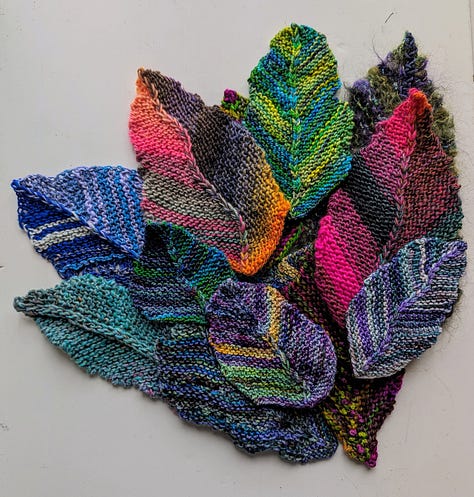
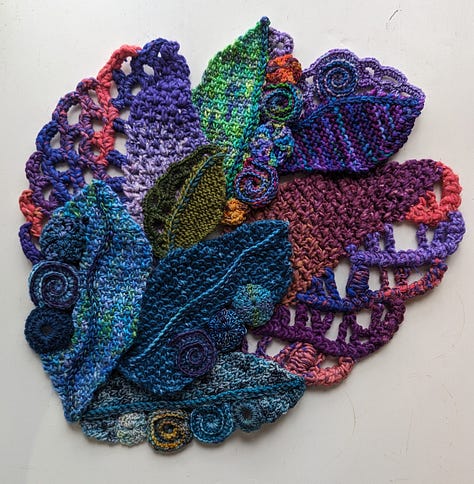

The first type, the mitered leaves, were incredibly satisfying to make because they were just complicated enough in construction to keep things interesting. Trial and error taught me how to play with mitered corners for a variety of effects. I love that this kind of shaping is possible in both knitting and crochet. Mitered leaves are simple enough to function as small motifs, but they could potentially become large leaf wraps that contain lots of freeform elements.
Next came the half and half leaves, which balance some type of plain, repetitive stitch work on one half of the leaf with a more freeform fabric on the other. For the plain sides, I used garter stitch, Tunisian simple stitch, and crocheted linen stitch. The free sides were as simple as a few circles for some leaves and as complicated as full on freeform in others. Half and half leaves would function well as small motifs, and they hold many possibilities for more complex, large leaf designs.
Then, it occurred to me that I could blend my obsession with spirals together with my quest for leaf designs. Making the spiral leaves is almost more fun than I can stand, obviously, and I made a ton of them. It was a pleasure to play with the shaping in these little leaves. Experimenting with a large leaf spiral isn’t out of the question, but I’ll probably stick with small ones to use in freeform since they’re so flexible and fun.
In fact, I enjoyed them so much during the 100 Days that I decided to go ahead and work some of them into a few languishing works in progress. The Tiny Poncho Cowl, a sari silk version of my Freeform Denim Tote, and the little scarf made with one slow color change yarn were all featured in issue 21 of this newsletter in varying states of completion. All contain at least a few spiral leaves, and all are finished now.
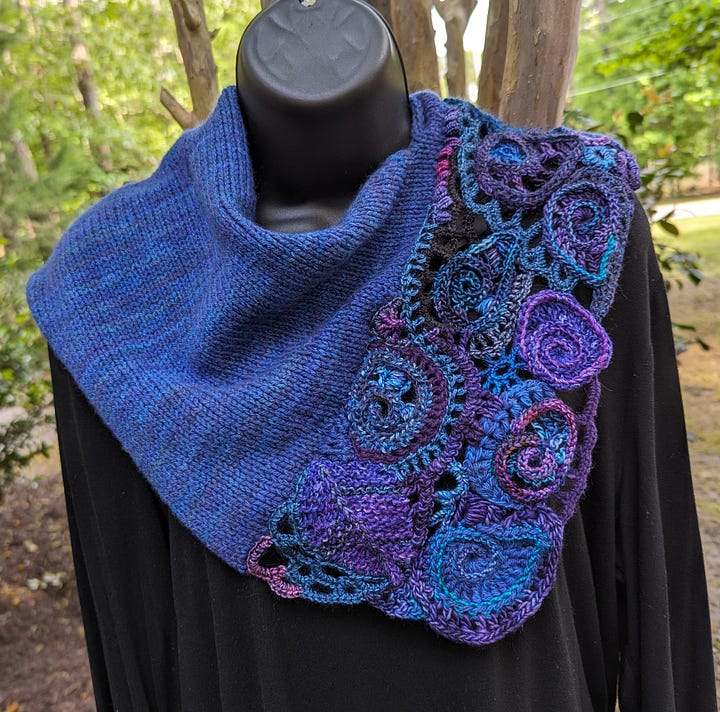
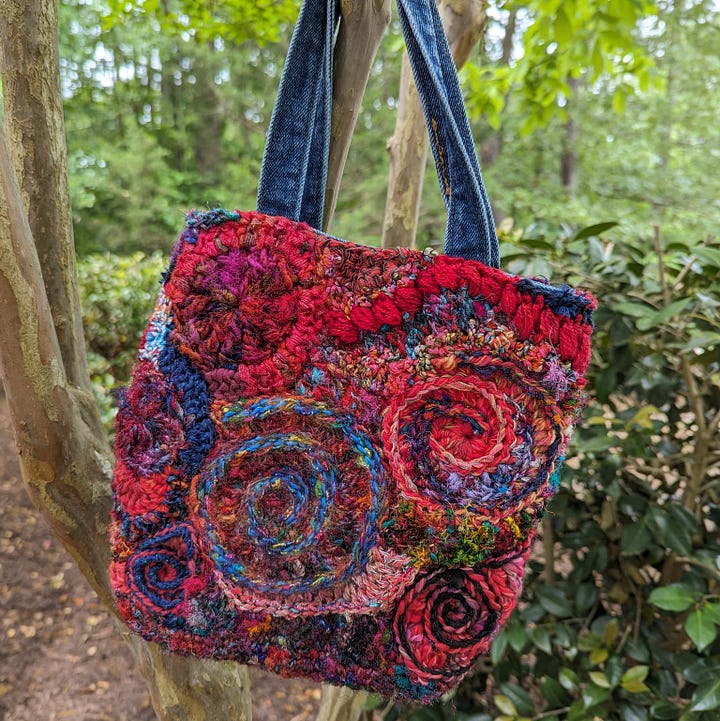
Since The 100 Day Project ended, I've relaxed my pace a bit, working slowly on a freeform capelet cowl. It has a plain knitted section that's been the perfect easygoing project for keeping busy while my mind swirls with large leaf shawl ideas.
what is it about the 100dp?
There’s something about doing a 100 Day Project that really keeps me engaged and focused. Realistically, I am in charge of what I’m knitting and crocheting, of course, but participating in the Project somehow gives me permission and space to fully immerse myself in a particular topic or technique. It feels good to be in that mode, so I’m considering doing some sort of short term version of the Project on my own. It might not be the same without the big group energy and the hashtags, and that’s ok, but will it allow for the same focus that I’ve felt in the big 100DPs this year and last year? I’m gonna think on it. If you have any experience with this, or if you want to experiment along with me in a shorter Project, let me know in the comments.
something to try
One of my favorite types of openwork to use in freeform is the freehand lace by Olga Poltava. Olga’s lace is elegant and flowing, but mine tends to look more like bubbles, so I call it bubble lace in my work.
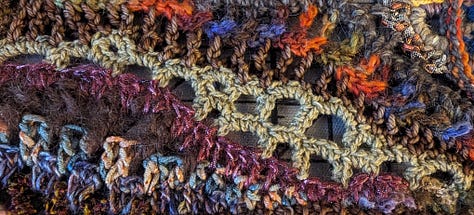
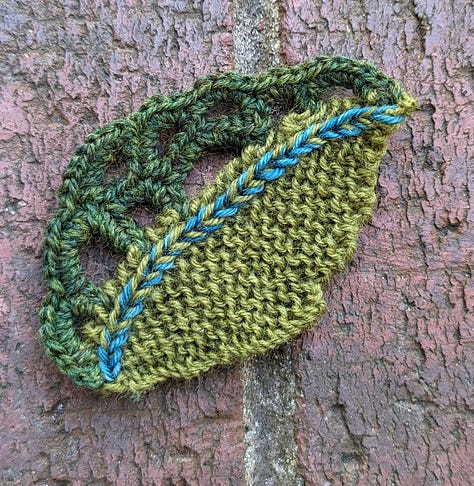

Recently, I’ve been playing around with ways to incorporate some graduated stitches into my bubble lace (see below) for variety. It's easy to do, especially if you've already tried out freehand lace using Olga’s video. It’s needlessly difficult to explain in writing, but if you watch the video (so very highly recommended!), you’ll see that to set up a section of freehand lace, you’re basically working left to right with single crochet stitches and chain stitches. After that set up, when you’re filling in and working into the empty chain sections, you’re working from right to left. This is the part of the lace where I’ve experimented with adding the graduated stitches. In the swatch below, there are lots of graduated stitches in the green yarn, and just a few in the purple.
The only rule to keep in mind when you change from one stitch height to another for a graduated effect is that you must do so without skipping a size. For example, a single crochet will graduate up to a half double, and a half double will always graduate up to a double. Skipping from a single directly to a double would create a gap. Graduating back down to smaller stitches works the same way, just in reverse. If it’s difficult to remember the order of stitch heights, make yourself a little reference card to keep handy. The order of stitch heights from short to tall is; SC, HDC, DC, TR, DTR, which translates to single, half double, double, treble, and double treble stitches.
You might notice that there are a few random texture stitches in the graduated stitch swatch above. There was no plan for these, they just happened where they happened. In the purple section, the texture is block stitch. In the pale blue, the texture is puff stitch. I find it very satisfying to combine stitches or techniques and find ways to fold these new combinations into my freeform work; that’s kind of what freeform is all about. The possibilities are endless.
I hope that you will try out some freehand lace. If you do, and if you think of other stitches or techniques to introduce into your swatch, try out your ideas as soon as you can. They’re too easy to forget if you wait til later, and you never know when you’ll end up with something that you really love.
something else you might like
Diana Menese Cunha’s large wall hangings use macrame and weaving together for bold, interesting texture.
That’s it for today, thanks for reading!
Lisa
PS If you try the freehand lace, or if you’ve tried making something from any of the other Something To Try sections from one of my newsletters, I’d love to hear all about how it went in the comments. Substack does not offer a way for commenters to share photos, but if you’d care to share your results in a photo on Instagram or Facebook, please tag me: lisadohertyfreeformanddesign.


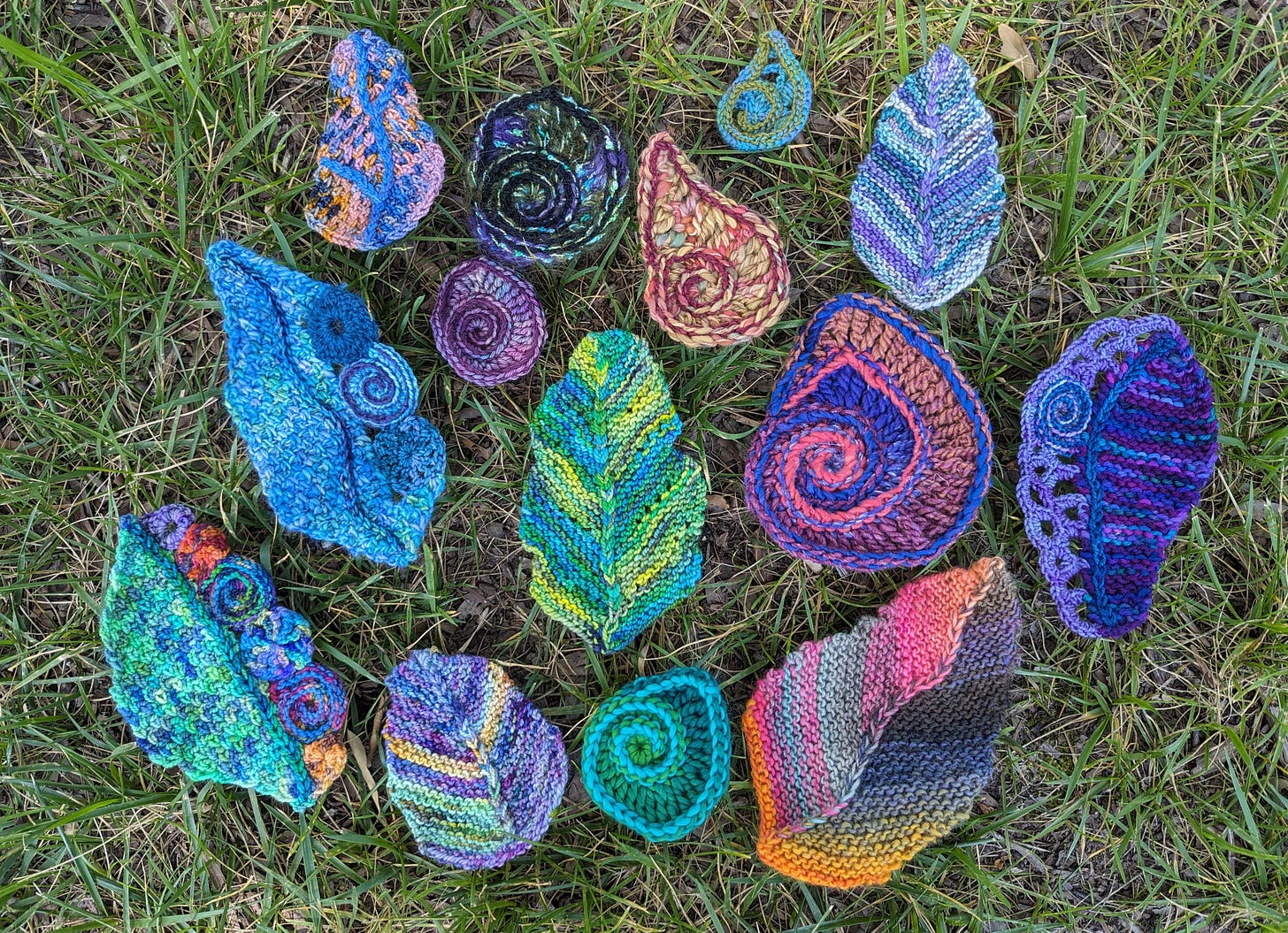
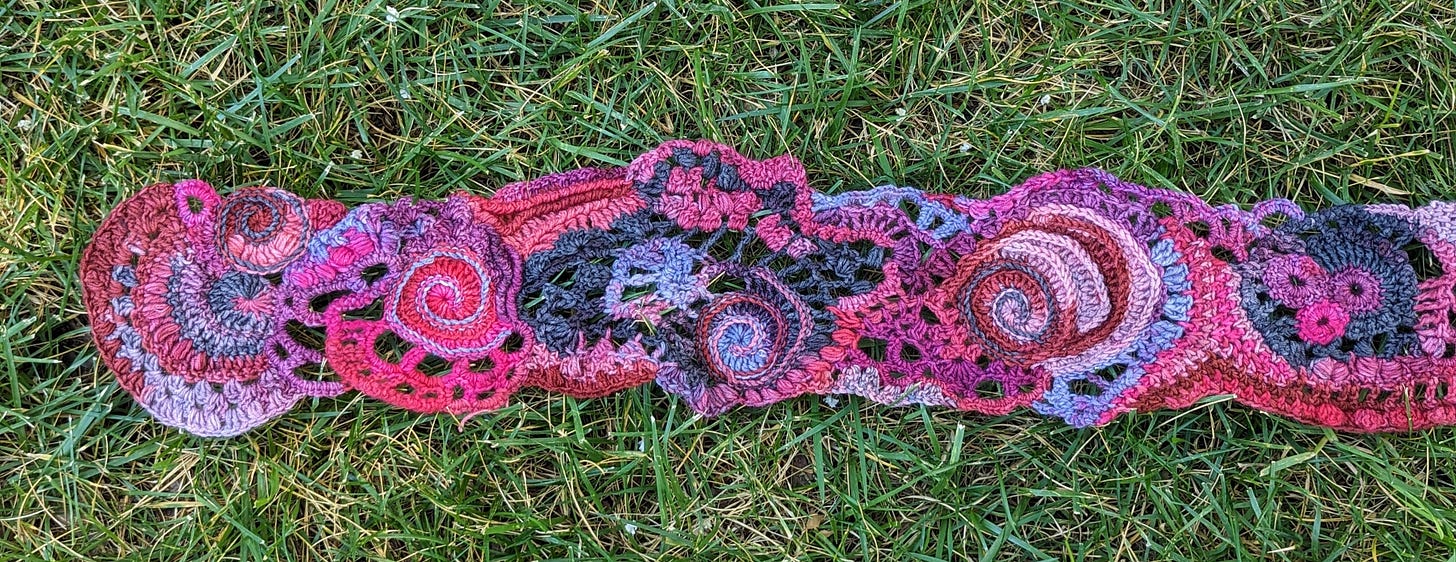
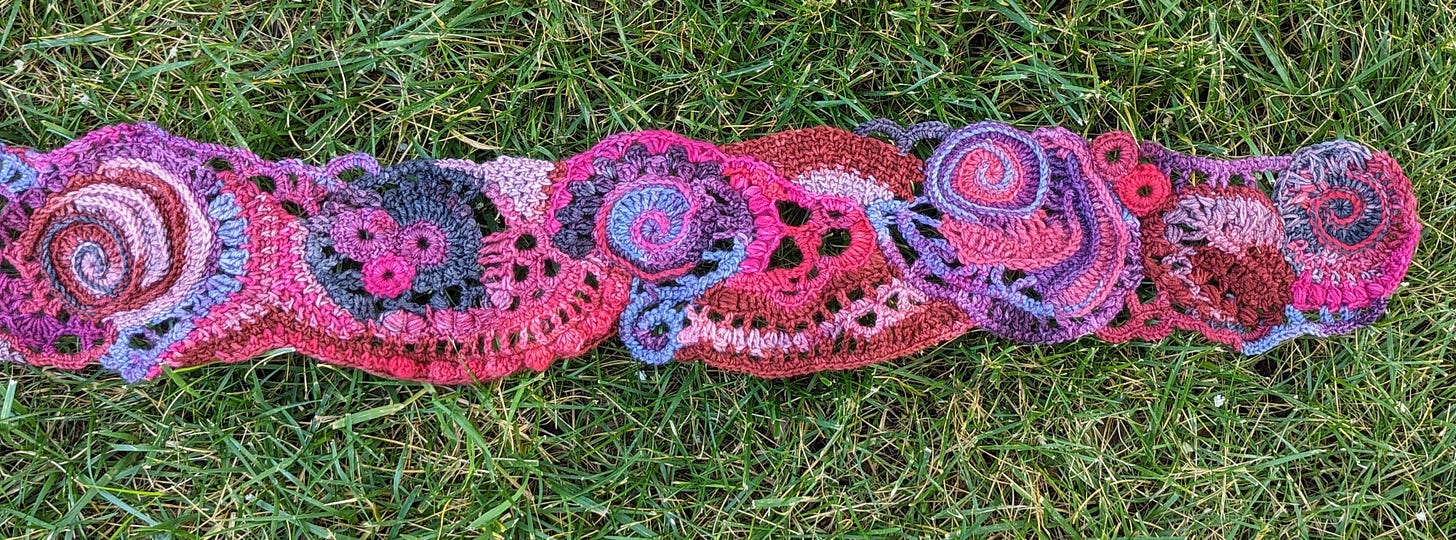

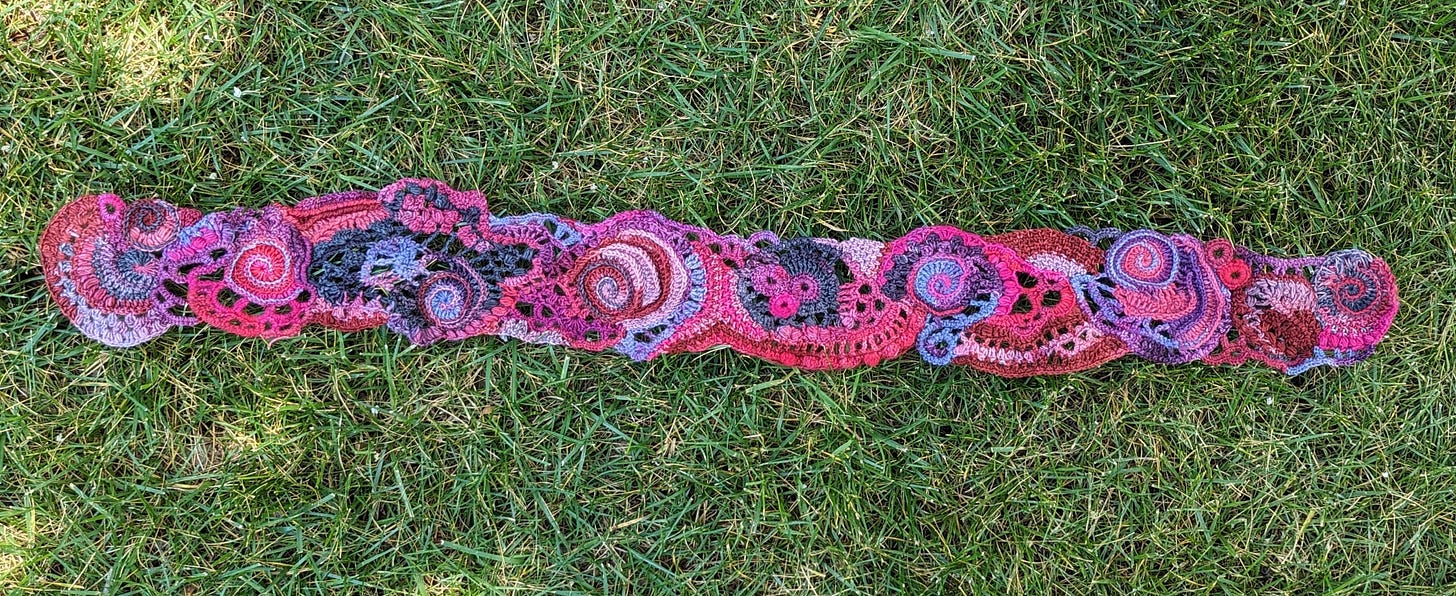
Stunning creations Lisa! In relation to this "but participating in the Project somehow gives me permission and space to fully immerse myself in a particular topic or technique. It feels good to be in that mode" You talk about the big group energy of the 100 day project. Apart from the benefits you've mentioned, what is it about this energy that helps you? I've never undertaken the 100 day project. My initial feeling is that it would be a huge undertaking and it would require considerable energy indeed.
Fabulous work